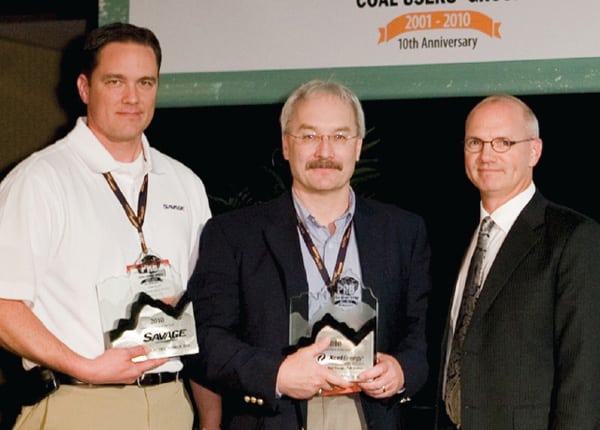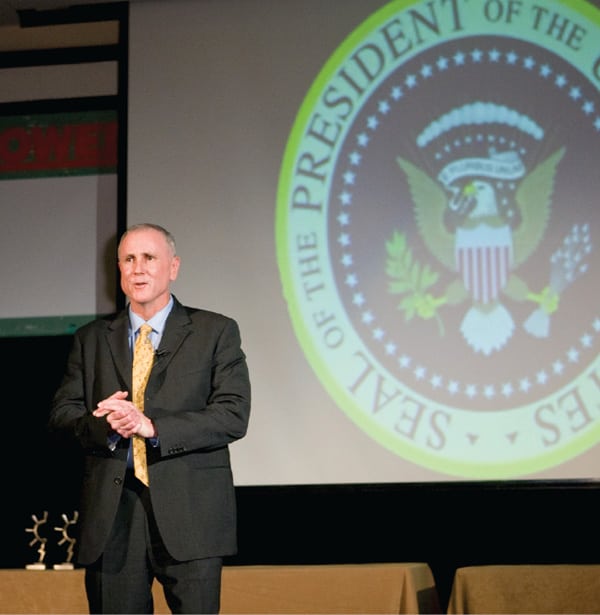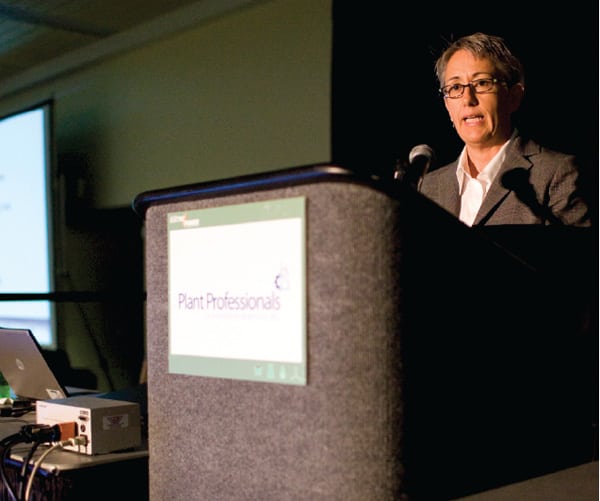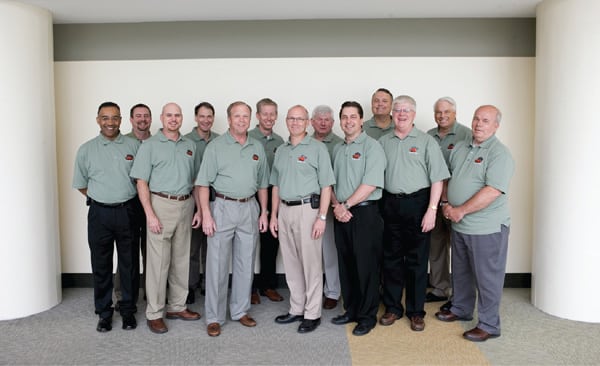PRB Coal Users’ Group Celebrates a Decade of Achievement
ELECTRIC POWER 2010
The 2010 Powder River Basin Users’ Group (PRBCUG) commemorated its 10th anniversary with 354 registered members (210 of whom were from operating companies) for its three-and-a-half-day annual meeting in Baltimore this May. The meeting’s Grand Sponsor was Benetech and its Plant Professionals group.
The Powder River Basin Coal Users’ Group (PRBCUG) is dedicated to providing the power industry with essential information required for the safe and efficient handling and burning of Powder River Basin coal. Education is the essential ingredient of a proactive program that safely and effectively manages PRB coal use, and education is the focus of our annual meetings. Sharing experiences, good and bad, improves the industry’s understanding of the peculiarities of burning PRB coal. The group’s interactive forum, colocated with the ELECTRIC POWER Conference & Exhibition (EP), gives members the opportunity to discuss PRB issues with their peers and make new friends whom they can call when the next problem unexpectedly appears at their plant. Here’s a roundup of some of the most memorable aspects of the group’s 10th anniversary meeting.
Plant of the Year Winner
The annual EP Power Plant Awards banquet took place on the evening of May 17 and included 259 PRBCUG delegates among the 315 attendees. As part of the evening’s festivities, the award for the PRBCUG’s Plant of the Year was presented to Xcel Energy’s Tolk Station and Savage-Tolk Energy Services (Figure 1). In a unique arrangement, Savage owns and operates the fuel-handling system at Tolk.
 |
| 1. Xcel’s excellent accomplishment. The PRBCUG’s Plant of the Year award went to Xcel Energy’s Tolk Station and Savage-Tolk Energy Services. From left to right, Byron Lawrence, general manager, Savage-Tolk Energy Services; David Low, plant director, Xcel Energy’s Tolk Station; and Greg Krieser, PRBCUG chairman. Source: POWER |
The Tolk Station and the Savage operations base their success on their culture. Tolk is a well-maintained and well-operated facility from rail receiving to the switchyard. The Tolk Station and Savage-Tolk Energy Services are hosting an open house on September 14, 2010. This is one plant you do not want to miss the opportunity to visit.
Recognition of Outstanding Students
Each year the PRBCUG sponsors a number of outstanding students from universities and colleges across the U.S. to attend EP and the PRBCUG’s annual meeting. This is an all-expense-paid trip for the students, mostly juniors in college, and an opportunity to be exposed to the coal-fired utility industry and the vendors that service this industry. It is the PRBCUG’s way of attracting some of the top students in the country to the coal-fired utility industry. Bob Taylor, PRBCUG secretary, coordinates the student sponsorship program.
The students pictured in Figure 2 received an Achievement Recognition Certificate from the PRBCUG for their outstanding academic performance, commitment, leadership, and dedication to continual improvement supporting the safe and efficient use of PRB coal.
 |
| 2. Tomorrow’s leaders. Seven college students each received an Achievement Recognition Certificate from the PRBCUG for their outstanding achievements. From left to right, back row: Randy Rahm, PRBCUG executive director; Clint King, South Dakota School of Mines & Technology; Ara Casada, University of Oklahoma; David Blake, West Virginia University; Brad Harris, Missouri S&T; Greg Krieser, PRBCUG chairman; and Bob Taylor, PRBCUG secretary. From left to right, front row: Jennifer Ward, South Dakota School of Mines and Technology; Katrina Nolte, Missouri S&T; and Vaidyanath Ramachandran, West Virginia University. Source: POWER |
Guest Speaker’s Philosophy Aims High
The banquet’s guest speaker, retired Colonel Mark W. Tillman was selected by the White House as the nation’s 12th presidential pilot (Figure 3). He served President George W. Bush as commander of Air Force One from 2001 to 2009. His tenure as the leader of a large organization was marked by excellence and adherence to a “zero fail” philosophy.
 |
| 3. Top gun. Retired Colonel Mark W. Tillman served President George W. Bush as his presidential pilot and commander of Air Force One from 2001 to 2009. Source: POWER |
Tillman commanded Air Force One through multiple national events. Most notably, he protected the president and his staff on September 11, 2001, by escaping and evading many potential threats. Through careful planning and flawless decision-making, Tillman and his crew provided two urgent needs for the president: complete safety and constant connection to the nation’s first responders.
Attendees were captivated by Tillman’s recounting of the events that occurred during his last assignment as commander of Air Force One. Tillman left us with a message that is applicable to the mission of the PRBCUG, its members, and the utility industry in general: “Zero failure doesn’t just happen… successful leaders make it happen.”
Chemical Safety Board Focuses on Combustible Dust
John Bresland, chairman and CEO of the Chemical Safety Board (CSB), was one of the many notable speakers at the annual meeting (Figure 4) that began the next morning. Bresland spent the majority of his career in the chemical industry before joining the CSB, which is an independent federal agency charged with investigating industrial chemical accidents, including explosions or fires caused by combustible coal dust. The CSB has a budget of $11.1 million in FY 2010. There are five board members (three at present) and a staff of 40, which is not nearly enough to cover the incidents, according to Bresland.
 |
| 4. Scoping out chemical accidents. John Bresland, chairman and CEO of the Chemical Safety Board, was a featured speaker at the PRBCUG Annual Meeting. Source: POWER |
The CSB finds out about incidents through Internet news feeds by using specific search terms, TV news reports, and the National Response Center, according to Bresland. How does the agency decide which accidents to investigate? It considers a number of factors, such as whether there was an injury or death involving a member of the public or employees of the involved industrial facility, or property loss inside or outside of the facility’s fence line.
Bresland also discussed the CSB’s Combustible Dust Study. This report was published in November 2006 and identified 281 incidents between 1980 and 2005 that included 119 fatalities. As a result of its findings, the CSB recommended that the Occupational Safety and Health Administration (OSHA) publish a combustible dust standard.
There has also been legislative action, with bills being introduced by Rep. George Miller (D-Calif.) requiring interim OSHA action, according to Bresland. HR 5522, “Worker Protection Against Combustible Dust Explosions and Fires Act of 2008,” passed the House but not the Senate, and HR 849, “Worker Protection Against Combustible Dust Explosions and Fires Act of 2009,” is still in committee.
OSHA’s Combustible Dust Rulemaking
Another session that dealt with the issue of regulating combustible dust featured Amanda Edens, OSHA deputy director, director of standards and guidance (Figure 5), and Bill Hamilton, OSHA fire protection engineer. These two speakers provided delegates with updates on recent rulemaking activities, ongoing efforts, National Emphasis Program inspections, and the next steps pertaining to OSHA’s combustible dust rulemaking. Edens reviewed recent activities:
 |
| 5. Putting the heat on. Amanda Edens, OSHA’s deputy director, directorate of standards and guidance, updated PRBCUG members on OSHA’s combustible dust rulemaking, which OSHA is strongly pursuing. If not properly controlled, coal and coal dust can cause fires, explosions, and implosions at power plants. Source: POWER |
- April 2009: Secretary of Labor Hilda Solis announced that the U.S. Department of Labor would pursue rulemaking for combustible dust hazards.
- May 2009: Combustible dust was added to the regulatory agenda.
- October 2009: The advanced notice of proposed rulemaking (ANPR) was published, soliciting input from the public.
So far there have been more than 110 submittals, according to Edens. The PRBCUG was one of the entities that submitted comments. All comments submitted in response to the ANPR can be viewed by visiting http://www.regulations.gov.
PRB Coal Conversion Case Study: C.P. Crane Power Plant
In his session, Paul Cain, project director at Constellation Energy, outlined the process of converting the fuel used by the C.P. Crane Power Plant located in Baltimore County, Md., to PRB coal. He began by focusing on the air quality requirements under Maryland’s Healthy Air Act, which establishes annual tons/year fleetwide caps for NOx, SO2, and mercury emissions. There are phased and target reductions from 2002 emission levels, according to Cain:
- Phase I: 70% reduction of NOx by 2009 and 80% reduction of SO2by 2010.
- Phase II: 75% reduction of NOx by 2012 and 85% reduction of SO2by 2013.
The space and capital costs for backend equipment at the C.P. Crane Power Plant were prohibitive. Converting to subbituminous coal offered a lower capital cost solution.
The plant consists of Unit 1, which has a 190-MW cyclone-fired selective noncatalytic reduction (SNCR) system with a baghouse, and Unit 2, which has a 195-MW cyclone-fired, SNCR system with a baghouse.
Cain highlighted the key lessons learned from his facility’s conversion to PRB coal:
- Senior management involvement is required to set expectations, especially regarding safety.
- Safety costs money.
- The plant needs to dedicate key resources for the conversion at the outset, and they need to be engaged early in the project plus plan for considerable time and effort.
- Be sure to include an assessment of the fly ash storage needs, especially with high loss on ignition.
- Ensure that there is a formal process to capture, review, and resolve plant and engineering comments to drawings.
- Ensure that there is sufficient contingency, as there will be considerable discovery.
- Invest time in developing a good schedule early in the project.
- There is substantial knowledge and experience in the industry today; some information may be conflicting or not always applicable to your specific situation. Most importantly, find a trusted expert that can help guide you through the latest industry experience.
- Consult the PRBCUG and other PRB coal users, as they are generally willing to help and are tied by the common bond of safety for any user.
Cain and Constellation Energy went through a painstaking process to incorporate the best practices and technologies in the industry to minimize coal dust in their new system. As a result, the C.P. Crane Power Plant is a showcase and will be a preferred destination for any utility contemplating converting to a subbituminous coal or wanting to upgrade its existing coal-handling system to minimize the generation of coal dust.
Moving in New Directions
The PRBCUG has become an international resource for best available practices and technologies in handling, storing, and burning subbituminous coals and for its library of past presentations. This year the PRBCUG went international with attendees as well, including its first international sponsor, CLP Power Hong Kong Ltd. CLP sent four representatives to the PRBCUG annual meeting, including Edward Chiu, station manager, Castle Peak Power Station. Hong Kong Electric Co. Ltd. sent two representatives from the Lamma Power Station, and Drax Power Ltd. sent four representatives from the Drax Power Station in the U.K. (See the feature story on the Drax station in this issue.)
More than 200 million tons of Indonesian subbituminous coal are exported annually, and more than 4 million tons of PRB coal were exported in 2009. Demand for PRB coal is growing in both the Asian and European markets, and export estimates for 2011 are 10 million tons, providing port capacity is available. Those numbers mean the value of PRBCUG participation continues to grow worldwide.
—Randy Rahm ([email protected]) is executive director of the PRBCUG. He is also president of CoalTech Consultants Inc. in Topeka, Kan.
